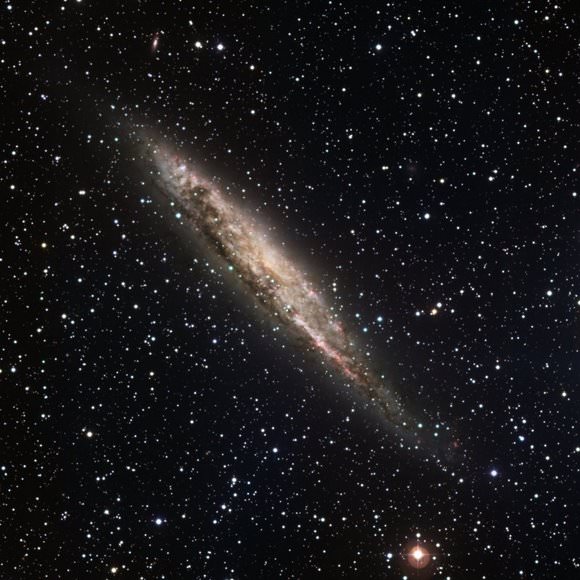[/caption]
Unfortunately, the Universe isn’t equipped with any three-panel dressing room mirrors, so we can’t see what our own Milky Way Galaxy looks like face on, or even from the side. But here’s a great new edge-on image of Galaxy NGC 4945, and many astronomers think this hive of stars closely resembles our own spiral galaxy with swirling, luminous arms and a bar-shaped central region. However, in sizing up this mirror-like image, does our black hole look that big? No, say astronomers from the European Southern Observatory. NGC 4945 has a brighter center that is likely home to a supermassive black hole bigger than the Milky Way’s, and it is devouring reams of matter and blasting energy out into space.
As NGC 4945 is only about 13 million light-years away in the constellation of Centaurus, a modest telescope is sufficient for skygazers to spot this remarkable galaxy.
James Dunlop, a Scottish astronomer, is credited with originally discovering NGC 4945 in 1826 from Australia.
For a closer view, click here to see a zoomable image of NGC 4945.
Today’s new portrait of NGC 4945 comes courtesy of the Wide Field Imager (WFI) instrument at the 2.2-metre MPG/ESO telescope at the La Silla Observatory in Chile. NGC 4945 appears cigar-shaped from our perspective on Earth, but the galaxy is actually a disc many times wider than it is thick, with bands of stars and glowing gas spiraling around its centre. With the use of special optical filters to isolate the color of light emitted by heated gases such as hydrogen, the image displays sharp contrasts in NGC 4945 that indicate areas of star formation.
Other observations have revealed that NGC 4945 has an active galactic nucleus, meaning its central bulge emits far more energy than calmer galaxies like the Milky Way.
Scientists classify NGC 4945 as a Seyfert galaxy after the American astronomer Carl K. Seyfert, who wrote a study in 1943 describing the odd light signatures emanating from some galactic cores. Since then, astronomers have come to suspect that supermassive black holes cause the turmoil in the centre of Seyfert galaxies. Black holes gravitationally draw gas and dust into them, accelerating and heating this attracted matter until it emits high-energy radiation, including X-rays and ultraviolet light. Most large, spiral galaxies, including the Milky Way, host a black hole in their centres, though many of these dark monsters no longer actively “feed” at this stage in galactic development.
Source: ESO


I wonder what the mass estimates are for the SMBH in NGC 4945 compared to our galaxys’ 3-4 million solar mass BH?
“However, looking at this mirror-like image, does our black hole look that big?”
*Giggle* The Andromeda Galaxy is saying “No, dear – those satellite galaxies don’t make your black hole look big.”
Is this galaxy just too thick or too near for an edge-on? I wonder how big the SMBH is while there is no sign of galactic bulge, at least optically.